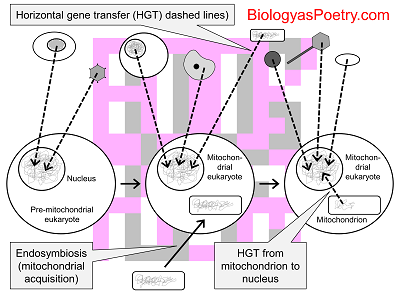∞ generated and posted on 2016.02.07 ∞
Movement of alleles between individual organisms but other than from parent to offspring.
Horizontal gene transfer is a form of genetic migration, one that can involve transfer of genes from one species to another rather than necessarily physical migration of individuals from one place to another.
, , and are used synonymously as too, to a more limited extent, can the term introgression be used equivalently.

Figure legend: Diverse mechanisms of horizontal gene transfer (HGT) to eukaryotic cells. Sources include viruses, other cells (both prokaryotic and eukaryotic), and endosymbionts. Acquisition of the latter, such as mitochondria, represents horizontal gene transfer alone, that is, the acquisition of the entire genome of another organisms, though subsequent HGT can take place as well in terms of gene movement from the endosymbiont's genome to the host-cell's nucleus. Except when viruses are intentionally integrating into host cells, all of these various mechanisms can be viewed as accidental gene acquisition, though the process of transformation, the picking up of naked DNA from the environment, might be more purposeful at least in terms of DNA acquisition.
Horizontal gene transfer is a rampant sexual mechanism among especially microorganism, contributing greatly, for example, to bacterial evolution (see bacterial sex), but also to that of eukaryotes.
Viruses also contribute to a horizontal gain in new genes by all cellular organisms including and ourselves. Viruses too can be subject to rampant horizontal gene transfer.